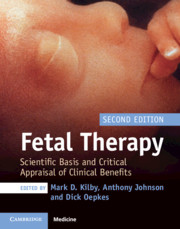Book contents
- Fetal Therapy
- Fetal Therapy
- Copyright page
- Dedication
- Contents
- Contributors
- Foreword
- Section 1: General Principles
- Section 2: Fetal Disease: Pathogenesis and Treatment
- Red Cell Alloimmunization
- Structural Heart Disease in the Fetus
- Fetal Dysrhythmias
- Manipulation of Fetal Amniotic Fluid Volume
- Fetal Infections
- Fetal Growth and Well-being
- Preterm Birth of the Singleton and Multiple Pregnancy
- Complications of Monochorionic Multiple Pregnancy: Twin-to-Twin Transfusion Syndrome
- Complications of Monochorionic Multiple Pregnancy: Fetal Growth Restriction in Monochorionic Twins
- Complications of Monochorionic Multiple Pregnancy: Twin Reversed Arterial Perfusion Sequence
- Complications of Monochorionic Multiple Pregnancy: Multifetal Reduction in Multiple Pregnancy
- Fetal Urinary Tract Obstruction
- Pleural Effusion and Pulmonary Pathology
- Surgical Correction of Neural Tube Anomalies
- Chapter 43 Neural Tube Anomalies: An Update on the Pathophysiology and Prevention
- Chapter 44 Neural Tube Anomalies: Clinical Management by Open Fetal Surgery
- Chapter 45 Open Neural Tube Defect Repair: Development and Refinement of a Fetoscopic Technique
- Fetal Tumors
- Congenital Diaphragmatic Hernia
- Fetal Stem Cell Transplantation
- Gene Therapy
- Section III: The Future
- Index
- References
Chapter 45 - Open Neural Tube Defect Repair: Development and Refinement of a Fetoscopic Technique
from Surgical Correction of Neural Tube Anomalies
Published online by Cambridge University Press: 21 October 2019
- Fetal Therapy
- Fetal Therapy
- Copyright page
- Dedication
- Contents
- Contributors
- Foreword
- Section 1: General Principles
- Section 2: Fetal Disease: Pathogenesis and Treatment
- Red Cell Alloimmunization
- Structural Heart Disease in the Fetus
- Fetal Dysrhythmias
- Manipulation of Fetal Amniotic Fluid Volume
- Fetal Infections
- Fetal Growth and Well-being
- Preterm Birth of the Singleton and Multiple Pregnancy
- Complications of Monochorionic Multiple Pregnancy: Twin-to-Twin Transfusion Syndrome
- Complications of Monochorionic Multiple Pregnancy: Fetal Growth Restriction in Monochorionic Twins
- Complications of Monochorionic Multiple Pregnancy: Twin Reversed Arterial Perfusion Sequence
- Complications of Monochorionic Multiple Pregnancy: Multifetal Reduction in Multiple Pregnancy
- Fetal Urinary Tract Obstruction
- Pleural Effusion and Pulmonary Pathology
- Surgical Correction of Neural Tube Anomalies
- Chapter 43 Neural Tube Anomalies: An Update on the Pathophysiology and Prevention
- Chapter 44 Neural Tube Anomalies: Clinical Management by Open Fetal Surgery
- Chapter 45 Open Neural Tube Defect Repair: Development and Refinement of a Fetoscopic Technique
- Fetal Tumors
- Congenital Diaphragmatic Hernia
- Fetal Stem Cell Transplantation
- Gene Therapy
- Section III: The Future
- Index
- References
Summary
Fetal surgery has evolved over the last three decades from an innovative and ambitious concept into an accepted reality. The metamorphosis from curiosity to sought-after therapy has been driven by the refinement of techniques used in open hysterotomy surgeries, advances in the available technology and instrumentation, expansion of the repertoire of minimally invasive image-guided percutaneous interventions, and the development of safe and effective fetoscopic surgical procedures. Serious complications associated with the early era fetal surgery procedures such as intraoperative fetal death, abruptio placentae and pulmonary edema have been largely eliminated, and extreme preterm delivery (<28 weeks) has been significantly reduced. Specialized anesthesia protocols and intraoperative management algorithms have led to improved fetal tolerance of these procedures, and advancements in neonatal intensive care have dramatically improved neonatal outcomes.
- Type
- Chapter
- Information
- Fetal TherapyScientific Basis and Critical Appraisal of Clinical Benefits, pp. 467 - 479Publisher: Cambridge University PressPrint publication year: 2020

